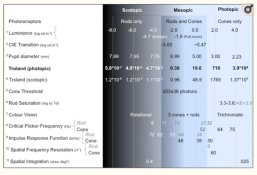Please come back with some pubmed reference and then a discussion could be started.
Nature communications?
Are u kiddin' me?
You seem to be a great misunderstanding here. It is not my position that needs to be backed up, it is yours. Your position is absolutely ludicrous, as A) It has no evidence. B) It has no reasoning. C) It is completely logically flawed and D) It is completely against accepted settled established science. You need to turn to a mirror and ask yourself that, because your flat out rejection of basic science and fundamentalist mindset are quite worrying. You need to stop spreading this misinformation here. It is wrong. There is no discussion to be had about this, it is not an opinion, it is a matter of fact, it is flat out wrong.
You even reject basic logic. You have ignored it multiple times already.
dMax is not light intensity, light intensity and the sensitivity of the human eye are independent of dMax.
Optical density is the measure of how much something reduces incoming light. An OD of 1.0 could give a luminance of 100 cd/m^2, and OD of 4.0 could give a luminosity of 1,000,000 cd/m^2. 1,000,000 cd/m^2 is far more visible than 100 cd/m^2. Claiming that the human eye cannot see beyond 2.4d is stupidly and fundamentally wrong, it is not how it works at all. The sensitivity of the human eye is measured by absolute luminosity or absolute light intensity, absolute number of photons, etc. It is
not measured by, determined by, or otherwise influenced by a relative reduction in luminosity or light intensity. Optical density or dMax gives you a relative reduction in light intensity. It does not magically make the photons coming out the other side undetectable.
Any claim that says the human eye cannot see details beyond an optical density of 2.4 is absolute rubbish and should not even be entertained for a second. Optical density is not a meaningful measurement in regards to the sensitivity of the human eye, it is literally impossible as it does not say how much light is coming through. It does not matter who says it, it does not make it any less wrong.
http://research.physics.illinois.edu/QI/Photonics/pdf/PWDec16Holmes.pdf
https://www.ncbi.nlm.nih.gov/pmc/articles/PMC4302711/












